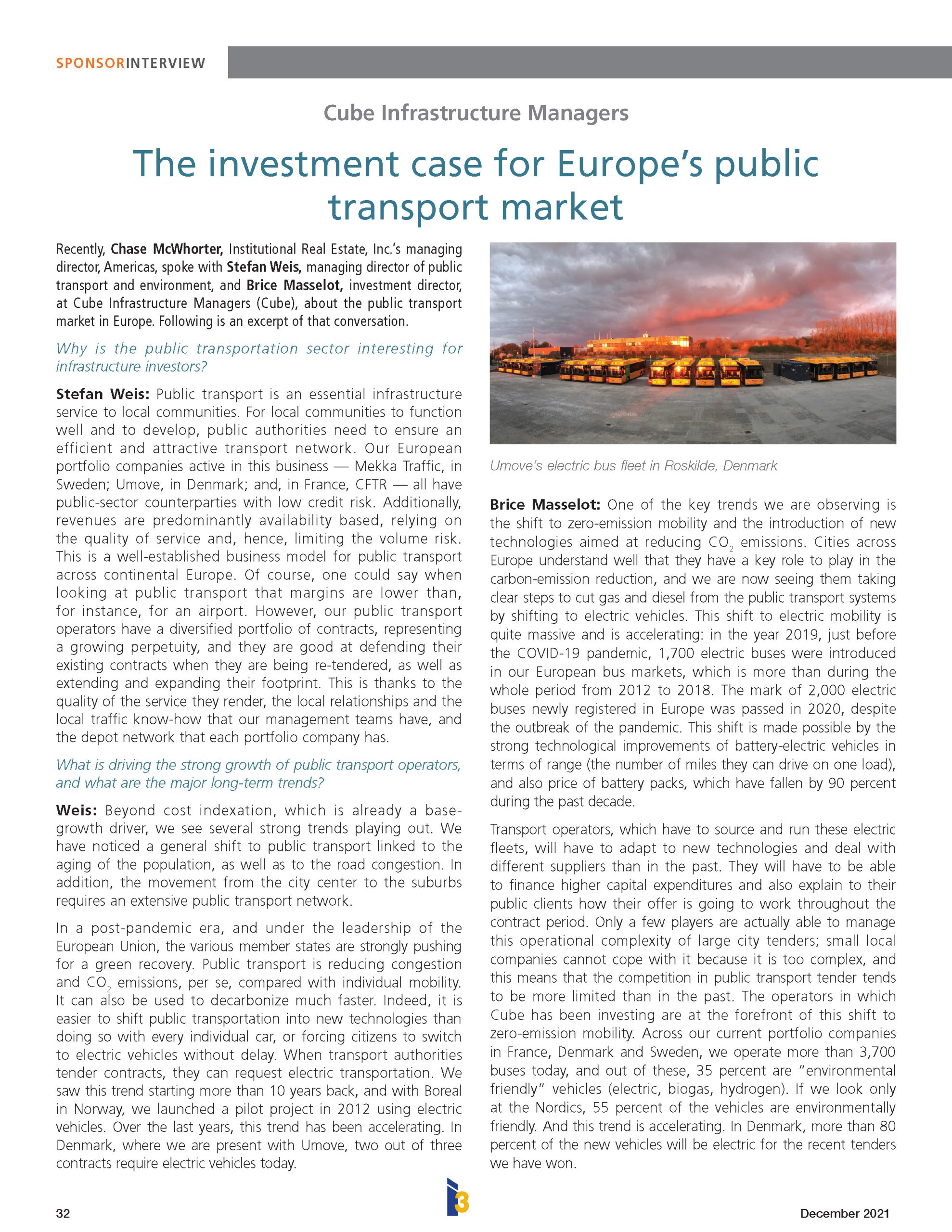Recently, Chase McWhorter, Institutional Real Estate, Inc.’s managing director, Americas, spoke with Stefan Weis, managing director of public transport and environment, and Brice Masselot, investment director, at Cube Infrastructure Managers (Cube), about the public transport market in Europe. Following is an excerpt of that conversation.
Why is the public transportation sector interesting for infrastructure investors?
Stefan Weis: Public transport is an essential infrastructure service to local communities. For local communities to function well and to develop, public authorities need to ensure an efficient and attractive transport network. Our European portfolio companies active in this business — Mekka Traffic, in Sweden; Umove, in Denmark; and, in France, CFTR — all have public-sector counterparties with low credit risk. Additionally, revenues are predominantly availability based, relying on the quality of service and, hence, limiting the volume risk. This is a well-established business model for public transport across continental Europe. Of course, one could say when looking at public transport that margins are lower than, for instance, for an airport. However, our public transport operators have a diversified portfolio of contracts, representing a growing perpetuity, and they are good at defending their existing contracts when they are being re-tendered, as well as extending and expanding their footprint. This is thanks to the quality of the service they render, the local relationships and the local traffic know-how that our management teams have, and the depot network that each portfolio company has.
What is driving the strong growth of public transport operators, and what are the major long-term trends?
Weis: Beyond cost indexation, which is already a base- growth driver, we see several strong trends playing out. We have noticed a general shift to public transport linked to the aging of the population, as well as to the road congestion. In addition, the movement from the city center to the suburbs requires an extensive public transport network.
In a post-pandemic era, and under the leadership of the European Union, the various member states are strongly pushing for a green recovery. Public transport is reducing congestion and CO2 emissions, per se, compared with individual mobility. It can also be used to decarbonize much faster. Indeed, it is easier to shift public transportation into new technologies than doing so with every individual car, or forcing citizens to switch to electric vehicles without delay. When transport authorities tender contracts, they can request electric transportation. We saw this trend starting more than 10 years back, and with Boreal in Norway, we launched a pilot project in 2012 using electric vehicles. Over the last years, this trend has been accelerating. In Denmark, where we are present with Umove, two out of three contracts require electric vehicles today.

Brice Masselot: One of the key trends we are observing is the shift to zero-emission mobility and the introduction of new technologies aimed at reducing CO2 emissions. Cities across Europe understand well that they have a key role to play in the carbon-emission reduction, and we are now seeing them taking clear steps to cut gas and diesel from the public transport systems by shifting to electric vehicles. This shift to electric mobility is quite massive and is accelerating: in the year 2019, just before the COVID-19 pandemic, 1,700 electric buses were introduced in our European bus markets, which is more than during the whole period from 2012 to 2018. The mark of 2,000 electric buses newly registered in Europe was passed in 2020, despite the outbreak of the pandemic. This shift is made possible by the strong technological improvements of battery-electric vehicles in terms of range (the number of miles they can drive on one load), and also price of battery packs, which have fallen by 90 percent during the past decade.
Transport operators, which have to source and run these electric fleets, will have to adapt to new technologies and deal with different suppliers than in the past. They will have to be able to finance higher capital expenditures and also explain to their public clients how their offer is going to work throughout the contract period. Only a few players are actually able to manage this operational complexity of large city tenders; small local companies cannot cope with it because it is too complex, and this means that the competition in public transport tender tends to be more limited than in the past. The operators in which Cube has been investing are at the forefront of this shift to zero-emission mobility. Across our current portfolio companies in France, Denmark and Sweden, we operate more than 3,700 buses today, and out of these, 35 percent are “environmental friendly” vehicles (electric, biogas, hydrogen). If we look only at the Nordics, 55 percent of the vehicles are environmentally friendly. And this trend is accelerating. In Denmark, more than 80 percent of the new vehicles will be electric for the recent tenders we have won.
How else has COVID-19 impacted the public transport market?
Masselot: What we have observed is that, while transport activities related to tourism were significantly impacted, the core business of our operators, which is commuter public transport — in other words, regular line bus traffic — is provided mainly on an availability-basis contract. These are contracts that are not exposed to the actual volume of passengers transported, and more generally, public transport systems have benefited from strong support throughout the pandemic from the public transport authorities, for which it was important to maintain adequate transport capacity, despite the decrease in ridership. Because public transport is so critical for a community to function well, authorities continued to pay, so that operators could deliver the required level of service. To us, the resilience demonstrated by public transport operators during a crisis of such magnitude is a clear confirmation that those public transport operations are fully relevant in an infrastructure investment portfolio.
Is there an increasing appetite for the public transport market?
Weis: As a mid-market buy-and-grow investor, we invest below the radar screen of our larger competitors. We seek to develop partnerships with founders and family-owned operators. We support them in their growth strategy and transformation, and then bring them to a size and positioning that is attractive to larger funds. We do that independent of the mode of public transport. This can be ferries, commuter rail or line-bus network operators. We have a strategic DNA at Cube, with longstanding experience managing and investing in this sector, and we benefit from a broad network and liberalization experience. In most of the cases, we are the key partner for entrepreneurs and families who want to further develop their businesses as independent operators.
And to answer your question, yes, we see an increasing interest for public transport, in particular when looking at our exits. We started investing early in the industry, and it is part of our overall strategy of investing in local and essential infrastructure services. We source a lot bilaterally, building partnerships, so we have a good competitive edge that we can continue to play out. We are benefiting from moderate multiples compared with other infrastructure industries, and we have public transport operators that just made their budget in the COVID-19 crisis, despite the massively reduced ridership, as it is predominantly availability based. I think more and more, other investors understand the merits of this sector.
“This is a great place to be, and you’ll see liberalization results in a better offering and more growth.”
STEFAN WEIS
Cube Infrastructure Managers
What are the biggest opportunities you’re seeing in the market right now?
Weis: In terms of opportunities, we see continuous, strong growth drivers in play, including green growth and electrification. As part of this, we also see increased focus on improved quality of the final service being rendered by our operators. Another important trend is that we see further liberalization across Europe, and as experienced now in greater Paris, where we are positioned with CFTR. The European Union is now pushing for its members to liberalize, which is happening at different speeds in different countries. State public procurement authorities and transport authorities need to tender, and they cannot continue to set up contracts on a bilateral basis. They really need to organize tender processes, where quality is becoming increasingly important. This is a great place to be, and you’ll see that liberalization results in a better offering and more growth.
Corporate Overview
Cube Infrastructure Managers is an independent management company focusing on investments in the European infrastructure space. The manager is constituted by a close-knit manager team with broad industrial and managerial experience, and with a highly international profile. Cube IM has €2.7 billion ($3.2 billion) in assets under management through four funds, all active in the European infrastructure space. Cube IM is a UNPRI signatory scored A+.
Contributors
Cube Infrastructure Managers
Stefan Weis
Managing Director of Public Transport and Environment
Brice Masselot
Investment Director
This article presents the authors’ opinions reflecting current market conditions. It has been prepared for informational and educational purposes only and should not be considered as investment advice or as a recommendation of any particular security, strategy or investment product.
